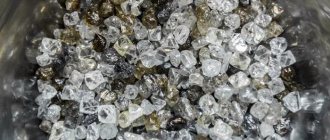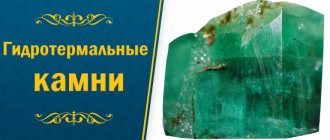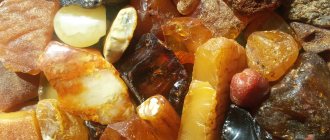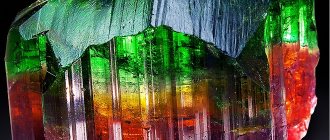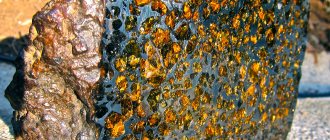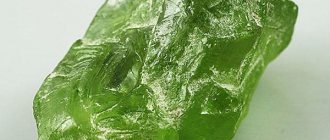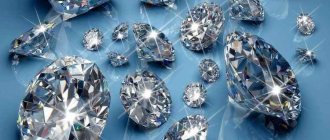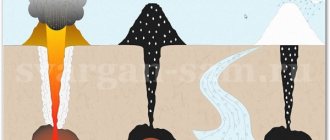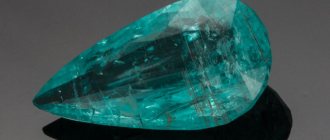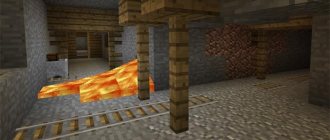Currently, in the jewelry market, the name “sapphire” is understood as jewelry.
varieties of corundum of any color except red - ruby.
Zoned corundum crystal. Madagascar
It is now customary to indicate the color of sapphire specifically. For example, green or yellow sapphire. If it says simply “sapphire”, we are talking only about a blue stone. Colorless sapphire is called leucosapphire. There is no sharp boundary between sapphires of pinkish-violet tones and rubies. Light red, pink and purple corundums are usually classified as sapphires: after all, among sapphires they are rated highly, but as rubies they would be considered low-grade.
Colored sapphires. Sri Lanka
Industrial deposits of sapphires are now located in Australia, Burma, Sri Lanka, Thailand, China, and Madagascar.
Raw sapphires from alluvial deposits of Sri Lanka
Australian sapphire deposits have been known since 1870. The quality of these stones is low. Their deep blue color becomes inky, greenish and even almost black under artificial light. Lighter stones also have a green tint. Black star sapphires have recently been discovered.
Selling pink sapphire. Sri Lanka
Sapphires mined in Sri Lanka are blue with a violet tint, yellow and orange, and are traded as “burqa”.
Padparadscha Sapphire
However, the most valuable are blue star sapphires with the optical effect of asterism.
Kashmir sapphires (India) are more prized than others. Their deposits are located in the highlands of the Himalayas and have been exploited with varying success since 1880.
Mountain trail leading to a sapphire mine in the state of Kashmir. India
The main quality of these stones is their color (intense cornflower blue, often with a silky sheen).
Raw materials of colored sapphires. India
Sapphires. Sri Lanka
Sapphire deposits are also known in Thailand, the USA, Brazil, Kampuchea, Kenya, Zimbabwe, and Tanzania.
Approximately 80% of sapphires in their raw form come to Bangkok, the rest are cut in Germany, Israel, Japan, where they are inserted into gold jewelry in combination with other precious stones.
Color-matched colored sapphires from various deposits
When visually diagnosed, benitoite, kyanite, synthetic spinel, spinel, topaz, zoisite, tourmaline, beryl, and iolite are similar in color to sapphire.
To distinguish natural sapphires from synthetic ones, the most reliable way is to study the internal features of the stone and study the color distribution. The study is carried out using a magnifying glass or microscope.
Sapphire crystal with inclusions
The most commonly observed inclusions in natural sapphires are inclusions of minerals: rutile (“silk”, mesh, asterism), spinel, apatite, garnets, ore opaque minerals.
Inclusions of rutile “silk” in natural sapphire
Color zones of varying intensity in natural sapphire
Characteristic features of natural sapphires under a microscope
In natural stones, zones of color of varying intensities can be observed. These zones form an angle of 120 degrees with each other, sometimes in the middle part of the stone. A reliable distinguishing feature of synthetic corundum obtained by the Verneuil method is the presence in them of mutually parallel (sometimes slightly wavy) layers, reminiscent of lines on a gramophone head. The appearance of such layers is due to the crystallization method itself, which involves supplying the charge powder to the top of the boule.
Doublets are often used to imitate natural sapphire. To make them, the top of the stone is made of natural sapphire, which is glued along the girdle plane to the base of blue synthetic sapphire. If the setting makes it difficult to observe curved growth lines or bubbles at the base of the stone, a good indication of its nature will be whitish-blue or greenish luminescence when synthetic sapphires are irradiated with short-wave ultraviolet radiation.
Sapphire: description, history of origin
Sapphire has a crystalline shape and a glass-like luster. Corundums have the highest cost compared to other varieties of the mineral. They are considered the most famous and expensive. There are crystals of different colors, in the bulk you can find blue and light blue stones, sometimes you can find pink and yellow, purple and transparent ones.
Sapphire instantly captivated people immediately after its discovery. It is believed that it was first found in Asia by local residents.
In India there is a belief that such minerals give eternal existence to a person. One sage created an elixir, which kept the recipe secret and did not allow ordinary mortals to try the liquid on themselves. As a result, the elixir turned into a fossil.
Blue corundum is often called the monarch stone, because it used to enjoy great respect in all countries of the world and among rulers, and was considered a symbol of power and strength. Even King Solomon wore a ring with this crystal.
Helpful information
The name of sapphire cannot be unambiguous for stone specialists and jewelers. In science, only blue corundums are called sapphires. Well, jewelers consider almost all multi-colored minerals, except red, to be sapphires.
The name of the gem, according to some sources, came from an ancient language. The Greeks, Egyptians and Jews believed that the name referred specifically to lapis lazuli, and not to corundum. Many called the stone a particle of heaven or an azure yacht.
Sapphires from Russia: how Monocrystal maintains world leadership
Stavropol Monocrystal has strengthened its position as a global market leader in its niche. Most Russian companies can only dream of this, but life for the main player in the global market is not at all so rosy
Founder and owner of the Energomera concern Vladimir Polyakov (Photo: Ivan Kurinnoy for RBC)
“Two residents of the city of Stavropol created an organized group, which involved employees of one of the regional enterprises,” the press service of the Main Directorate of the Ministry of Internal Affairs for the Stavropol Territory reported in March. These people transferred information constituting a trade secret to “another organization” for money, causing damage of 14 million rubles, the press release says.
The affected company was not named. But the local agency “Regional Reporter,” citing a source in the security forces, clarified that he was: the accused tried to steal his technology for the production of artificial sapphires, and the criminal case itself was the result of “a special operation against Chinese industrial intelligence and Chinese industrial espionage specialists.” Monocrystal grows artificial sapphires and makes sapphire substrates from them, which are used for the production of light-emitting diodes (LEDs). The same sapphires are used to make glass for the screens of some mobile phones and watches, including the smart Apple Watch. The plant exports almost all of its products and is the world's largest producer of sapphires, occupying 20 to 30% of this market, overtaking companies from China, Taiwan, Japan and the United States.
“For the last five or six years, they have been trying to steal Monocrystal technology, but without success. So far we do not see exact copies of technologies,” says Vladislav Tropko, investment director of Rusnano, which bought 5% of Monocrystal in 2011 for $42 million.
They didn’t talk to RBC about Chinese spies at Monocrystal, but secrets are protected here: at the entrance they give out stickers, with which you need to cover the camera on your phone. But before the RBC correspondent arrived, the stickers ran out. “Go ahead,” they waved their hand at the security booth.
Capacity utilization
62-year-old Vladimir Polyakov is reluctant to communicate with the press, speaks in a low voice and thinks for a long time before answering each question. He doesn't look at all like the innovator we might imagine from the glossy success stories of American tech entrepreneurs. Polyakov is the founder and owner (he owns 86.1% of the shares) of the Energomera concern, which includes Monocrystal. In 2015, he took 192nd place in the Russian Forbes ranking with a fortune of $400 million; he is not in this year’s ranking.
For half of his adult life, Polyakov worked for the country's defense: for about 13 years - at the Gomel Radio Plant, where he started as an equipment adjuster and ended up as deputy chief engineer. In 1989 he became the chief engineer of Stavropol, and in 1994 he went into business. The Energomera concern began with the production of electricity meters and throughout the 1990s, mainly in the Stavropol Territory, it bought up shares of small factories that in Soviet times worked for the defense industry and experienced problems with sales of products. One of them was the Analog plant of electronic devices and materials, which was engaged in growing monocrystalline silicon and producing silicon wafers for microcircuits and transistors and unsuccessfully tried to establish conversion. Polyakov bought a controlling stake in Analogue for $1 million.
In 1999, Analogue was transformed into Monocrystal OJSC, in which Polyakov identified five enterprises. Three, including those related to silicon, had to be closed a few years later, two more - the production of sapphire and resistive pastes - had no sales in Russia, they had to be brought to the world market, “where, naturally, no one was waiting for us,” recalls Polyakov. “There was no great foresight in my decision to go into sapphire; I was simply trying to make the most of the existing equipment at the plant,” he adds.
Girls' best friends
Analog learned how to produce sapphires back in 1984, and the technology used by the plant for growing single crystals using the Kyropoulas method has been known since 1926. Crystals are grown in growth machines - large metal tanks with displays. Aluminum oxide is poured into it, heated under special conditions to more than 2 thousand degrees Celsius, and after a few weeks the finished sapphire, the so-called boule, is extracted. Then it is cut, cut into cylinders and briquettes, and these, in turn, into plates, which are polished in special devices.
Today, the largest consumers of sapphire wafers, or substrates, are LED manufacturers, but in the late 1990s the market was still in its infancy. And Monocrystal began with the production of sapphire glasses, which watch companies were ready to buy.
To establish work in foreign markets, Polyakov hired graduates of local linguistic universities, who had to work for some time at Monocrystal in working positions, mainly in technical control operations - “to stop being afraid of the product”, then learned how to draw up contracts and customs documents. Polyakov sent those who passed this stage to foreign exhibitions.
“Beautiful girls looked good against the background of sapphire,” recalls Polyakov. “At first they came to see what kind of girls were there, but over time serious clients appeared.”
“At that time, LEDs were produced by unknown companies. Some of them no one will remember now, but there are also those that over the years have become market leaders with a multi-billion dollar turnover. “Both of them were our first customers,” says Monocrystal general director Oleg Kachalov, who came to the idea that they were unconvincing and amounted to $5–10 thousand per month,” Polyakov clarifies.
When the industry became interesting to large companies, some of them bought up small producers and continued to work with Monocrystal. This happened with the Taiwanese company Epistar, which absorbed all Taiwanese LED startups and has now become one of the largest LED manufacturers. But other giants, such as Samsung and LG, built this business from scratch, and relationships with them had to be built from the beginning. According to Kachalov, this process usually took two to three years. “The testing process itself takes about a year. But even before they start testing you, you have to build these relationships for about a year at all levels - from purchasing and sales, then with technical specialists and ending with relationships at the top management level,” he says.
The research company Yole Developpement lists the Chinese Fujian San'an, the Korean Hansol Technics and Iljin Display, and the American Caterpillar among Monocrystal's clients. Monocrystal itself does not disclose its customers, but Kachalov claims that the plant now cooperates with six of the ten largest LED manufacturers in the world (mainly Chinese and Taiwanese companies).
About 70% of Monocrystal's revenue comes from LEDs, 25% from mobile electronics, protective glass for cameras, glass for fingerprint scanners, screens for Apple and Huawei smart watches, 5% from other products, including glass for regular watches and protective optics in lasers.
“I have been saying for many years that the day will come when we will wake up rich and famous, because the sapphire market will explode,” repeats Vladimir Polyakov (Photo: Ivan Kurinnoy for RBC)
Up and down
Since the mid-2000s, the LED market has grown at 20–30% per year, driven primarily by demand for LEDs used in lighting. But in 2010, a small revolution occurred: Samsung used LEDs to backlight a TV screen for the first time. Other companies immediately followed suit, which caused a one-time shortage on the world market - prices for two-inch sapphire substrates for LEDs almost quadrupled over the year - from $4.7 to $16.7.
In the first years, Monocrystal did not bring profit to Polyakov - it had to be subsidized by the production of meters. But in 2010, the plant increased revenue by almost 3.5 times, to $89 million. “In two years, we made a profit of about $100 million, recouped all our investments and invested money in the further development of production,” recalls Polyakov. On this wave, Monocrystal, following one of its main competitors, the American Rubicon Technology, planned to enter an IPO, counting on a capitalization of $0.8–1.01 billion. In the same 2010, the company received a loan of $10 million for five years from the International Financial corporation, and the investment fund UCP of Ilya Shcherbovich became a minority shareholder of Monocrystal.
The sharp rise in prices for sapphires attracted new players to the market: in China alone, several dozen companies engaged in growing sapphires were founded in a short period of time, and prices began to fall already in 2011, and in 2012 they collapsed below the 2009 level - to $3. 2 per two-inch plate. Due to market volatility, Monocrystal's IPO was cancelled.
UCP left Monocrystal two years later: a Vedomosti source close to the fund claimed that the investment was “profitable” for him. In the summer of 2011, 5% of Monocrystal was bought for $42 million by Rusnano, which still owns this stake.
But prices continued to fall, and in the fall of 2014 the market experienced a new disappointment: Apple announced that it would not use sapphire glass in the iPhone 6 model. The scale of the disaster can be assessed by just one fact: in July 2014, the market capitalization of the American company GT Advanced Technologies (GTAT), which was going to supply Apple with sapphire glass for the iPhone, reached $2.8 billion. After Apple changed its mind, due to the fact that GTAT could not make screens of the required quality, the company almost immediately filed for bankruptcy.
In 2015, prices for sapphire wafers dropped to $2. Monocrystal has so far managed to maintain first place in the world market in terms of revenue. What does the Stavropol plant hope for?
300 kg
“Early on, we came to the conclusion that the main thing in this industry is the ability to grow a high-quality sapphire crystal as large as possible,” says Kachalov. “We had the same growing equipment as everyone else, and using equipment like everyone else, it’s difficult to do something outstanding.”
All manufacturers of artificial sapphires use the same technology, but each is trying to increase the size of the grown boule. The larger the crystal, the lower the power consumption, and therefore the cost. Larger die can be cut into larger wafers: the industry has moved almost entirely from two-inch wafers to four-inch wafers and is now moving to six inches. Finally, there is a direct relationship between the size of the crystal and its quality: the larger it is, the clearer the crystal lattice.
Monocrystal began to develop its own growth units, and in 2004, their first generation was produced at the Energomer production facilities. In 2015, the company grew a sapphire single crystal weighing 300 kg—no one has yet managed to surpass the record: its closest competitor, the American Rubicon Technology, is stuck at 200 kg, Kachalov says proudly. “Crystals weighing about 10 kg were grown at Analog,” he adds.
While trying to grow a crystal of a record size, GTAT, in which Apple invested more than $1 billion, also failed. GTAT, after an agreement with Apple, planned to grow boules weighing approximately 290 kg, but before that the company only made growth furnaces and did not try to grow crystals. As a result, according to the Wall Street Journal, the backyard of the GTAT factories resembled a “boule graveyard” - the crystals were cracked and completely unusable.
“It’s difficult to enter the world market, but it’s even more difficult to stay on it,” says Dmitry Loigas, a technologist at Kama Crystal Technology, a company that recently began producing artificial sapphire in Naberezhnye Chelny. “To do this, we need to reduce the price every year.” In 2014–2015, the devaluation of the ruble played into the hands of Monocrystal. In addition, according to Kachalov, even before the exchange rate change, the gap in the cost of sapphires with its closest competitors at the Stavropol plant was more than twofold. According to the forecast of the general director of Monocrystal, prices will continue to fall in the near future - by at least 10% per year.
The race to reduce costs has been going on at Monocrystal almost from the very beginning: every year it is reduced by 30%, says Kachalov. There is an effect from an increase in the scale of production - since its founding, the capacity has increased several times (the company does not disclose the exact figure). But the company is not counting only on production capacity.
Process improvement
The words that both Polyakov and Kachalov use in conversation more often than others are “continuous improvement” and “production system.” Polyakov borrowed the philosophy of kaizen, continuous process improvement, from Toyota. He says that in the mid-2000s he realized: the Soviet experience is not enough, we need to look for something new in the experience of others, everyone must continuously improve everything.
“The purchasing manager must extract discounts, and the technologist must produce more product with fewer resources, make it of better quality,” Kachalov tries to explain. “We are constantly thinking about how to spend less material, do it in a shorter time, and achieve higher quality. When this work is prescribed in the instructions, then you achieve the predicted high result.”
Polyakov himself spends four hours a day in kaizen teams with engineers, he says.
Like other companies whose leaders are passionate about kaizen (in Russia, these include, for example, German Gref and Oleg Deripaska), Monocrystal has instructions for everything: from general policies describing global processes like personnel management or sales, to standard operating cards, where each operation is described in detail - literally down to the diagram for finding the “On” button on the system unit.
Around 2010, Polyakov introduced selection of the best and worst employees at Monocrystal - “personnel differentiation” borrowed from General Electric. In addition to their main responsibilities, employees must make suggestions to optimize their work or the operation of the plant. If the proposal is accepted, points are awarded for it. “Points can be earned for any process modification that improves something, speeds it up or makes a profit,” says a former Monocrystal employee who asked not to be named. “You can, for example, get points for improving your job description.” Every year in the fall the commission calculates the points. As a result, employees are divided into categories: A, B, B+ and C. A is the “golden” reserve, C is the worst employees.
When asked what happens to category C employees, Polyakov says, slightly embarrassed: “We don’t lay off anyone, we simply announce to the employee that he has fallen into category C and he has no great prospects in the company. As a rule, after this people gradually leave.” Employees who fall into the worst category see everything a little differently.
“They started dumping things on me that I didn’t like and weren’t part of my responsibilities. I said I don't like it. I was told that I was in category C and could be fired under the article,” says a former employee of the plant. “They gave me a month to find a job, but I decided not to leave.” The pressure began: God forbid you are late or forget something! I got to the point where I wrote reports every day about what I was doing at work. In the end, I worked for three months and left on my own: I was tired.” Polyakov is sure: without technology built on the race, one cannot survive.
Light and darkness
The LEDinside industry portal describes the state of the market for LED components in 2015 as “gloomy”: according to a report from the consulting company Strategies Unlimited, it’s all due to an oversupply and a price drop that is outstripping forecasts. The company's analysts believe that in the next five years the market volume in monetary terms will grow by no more than 4.5% per year.
“Most companies in the sapphire industry have been losing money for the past three years,” Jerry Chen, general manager of Monocrystal in Taiwan, said at a conference in Taipei this spring. According to him, during this time three of the 12 leading manufacturers of artificial sapphires left the market. Monocrystal sees new opportunities in this: according to Chen, in 2016 the company will increase its share of the global market to a solid 30% (he estimated the share in 2015 as “between 20 and 30%”).
Kachalov is confident that the main market driver will be LEDs for lighting. “LED lamps now occupy less than 5% of the overall market. But their share is growing, and this will continue for another five or six years,” he says.
Now the lion's share of the LED market falls on backlighting in phones and televisions, says Dmitry Bauman, director of scientific work at Inter RAO LED Systems Group of Companies. In his opinion, LED lamps are too expensive for the mass consumer, and sapphire substrates now have little effect on the price of lamps. The main part of the cost of a lamp is the power supply, housing, assembly, and prices for them are falling very slowly. “The main reserve for reducing the cost of lamps is an increase in sales volumes, and this will not increase until the lamps become significantly cheaper. A vicious circle,” says Bauman.
The smartwatch sector looks mixed, with Apple not releasing Apple Watch sales data. According to IDC, the company sold 12 million copies in a year, but analysts were counting on 20 million. Monocrystal and the entire market have another hope - greatly reduced sapphires can attract the attention of smartphone manufacturers. Currently, only the luxury manufacturer Vertu and Huawei use sapphire glass for screens, which released a limited edition of the Huawei P8 smartphone with sapphire glass for the Chinese market.
The release of mass-produced smartphones with sapphire screens would mean explosive growth for Monocrystal, says Kachalov. According to his estimates, a 5.5-inch sapphire screen for a smartphone now costs about $20. For mass products, this is expensive, says Evgeny Kuznetsov, commercial director of Vobis Computer (Highscreen smartphones): “The screen of a smartphone is a sandwich of several layers, there is a “screen”, a touch panel and protective glass. All together it costs $15–25. And here one layer is $20.”
Polyakov continues to invest money in expanding the capacity of Monocrystal. The plant, according to him, makes a “reasonable” profit: last year the EBITDA margin was 31%. “But the price of sapphire continues to fall. It’s hard to say how this year will end,” he says. Answering the question: “What would he invest $1 billion in now if he had it? - After thinking and sighing, Polyakov answers: “We would only develop our agricultural segment: the most stable and profitable industry.”
Place of Birth
Sapphire deposits are located in many parts of the planet, the most famous of them are:
- Kashmiri minerals are considered the most valuable in jewelry; they have a bright and original hue. The sapphire deposit appeared at the end of the nineteenth century due to a landslide in the mountains. Mining was carried out quite intensively for 10 years.
- Today, very active sapphire mining occurs in Thailand and Australia. The most ancient deposits are considered to be the territories of Sri Lanka, Russia, India and Madagascar. Such specimens have a very diverse range of colors.
- Ceylon is famous for the extraction of minerals of all possible shades, and the black variety is also found in this area.
- Sapphire mining currently occurs in Cambodia in the Pailin province. The crystals look very rich and clear. They have a high cost.
In addition to those described above, there are other deposits of gems; they are located throughout the planet.
Varieties of sapphire
There are a huge number of types of crystals that can be classified as jewelry of the first category. Corundums of blue and deep shade have the greatest value. Other minerals are also popular; they are divided into several types:
- leucosapphire is transparent and has no color;
- padparadscha has a pale pink or orange color; such specimens can even be compared in price to diamonds;
- chlorosapphire has a bright green color, its appearance strongly resembles emeralds;
- the purple specimen bears the same name due to its rich color;
- star-shaped specimens are considered quite rare; inside them there are small crystals with six sides that look like stars.
Sapphires are considered quite famous, but among them there are other types:
- ruby is distinguished by its transparency and reddish color, it can be pale or rich; in jewelry, such crystals are very expensive;
- emery combines magnetite and corundum; it can be either natural or artificially created.
All species have unique characteristics and healing powers.
Characteristics
Now all corundums are called sapphires, with the exception of those that are red in color (rubies). From a chemical point of view, the description of the stone is as follows: sapphire is a mineral consisting almost entirely of aluminum oxide. It has a glassy luster and one of the highest strength values on the Mohs scale (the table indicates a number of 9 points). Only diamond is considered a harder mineral. The clarity and purity of sapphire can vary. There are both transparent stones, varying in purity, and completely opaque gems.
Some corundums are characterized by the phenomenon of asterism - the appearance on the surface of a stone of a star with six or twelve rays. This feature occurs in minerals with rutile inclusions, using a cutting method called “cabochon”. Star sapphires are more expensive than others.
Properties of sapphire
Blue crystals have various healing and magical properties, which became known in ancient times. Healers advise wearing it as a talisman against certain diseases, including:
- asthma;
- heart;
- skin and integument;
- kidneys;
- diabetes;
- genitals;
- headache;
- mental disorders;
- inflammatory processes.
Any variety of minerals can cope with such ailments, but crystals should also be used in accordance with the color scheme.
Important information
Corundum, regardless of color, is a female stone; it can help in the treatment of various diseases of the genital organs, allowing the birth of healthy offspring.
Sapphire mining is also considered widespread due to the fact that the mineral gives longevity and helps maintain sanity even in old age.
What distinguishes top-notch sapphires - which ones are considered the best?
The cost of sapphires is most influenced by their color. The color of a sapphire is even more significant than its purity. These stones are rarely completely pure, unlike, for example, diamonds, and even very expensive sapphires can contain inclusions.
Very slight variations in the color of sapphires can have a significant impact on the price. Excellent quality stones with good color and clarity are rare. The best and most highly prized shades for blue sapphires are violet-blue. Rich mid or dark shades are especially valued, while tones that are too dark or light are rated lower.
Jewelry with stone
Jewelry with sapphires can be high-end or have an acceptable price for consumers. The most expensive setting for jewelry is platinum; such jewelry can only be made to order. Their price reaches even tens of thousands of dollars.
Jewelry available to consumers is made in silver or gold frames. The inserts can be artificial stones or noble minerals.
Jewelry can be quite versatile due to the different shades and settings. Various cufflinks, rings and rings, tie pins are usually considered an exclusively male prerogative.
The most famous sapphires
There are the most famous minerals that are well known all over the world:
- One day I came across the largest specimen, which was later called the Star of India. It weighs 536 carats.
- The 116-carat Midnight Star is now kept in the American History Museum.
- The Asian star is in Washington at the institute, weighing 330 carats.
- Stuart and St. Edward are kept in London in the Queen's Treasury of Britain.
- Russia also possesses a mineral weighing 200 carats.
Modern people know very well that Princess Diana received a sapphire ring for her engagement; today it adorns the hand of her son’s wife. The ring looks quite ordinary, it does not attract too much attention, because the modest princess personally chose it for herself. However, this decoration sets an example of stylish jewelry and is extremely popular.
Jewelry with precious crystal has always been highly valued. According to beliefs and legends, they symbolized wisdom, purity of thoughts, chastity and fidelity. For a long time, the crystal was considered the most expensive among all others. In Rome, only priests in the temple had the right to wear it; in other countries, only clergy were allowed to use it. Even Cleopatra wore this decoration on her crown.
Production
Sapphire is a stone whose deposits are found on all continents except Antarctica. The most valuable and beautiful of them are considered to be minerals native to India and Tanzania. The island of Ceylon is also a popular place where sapphire is mined. In India, the Kashmir deposit was discovered after an earthquake, which exposed rich deposits of sapphires of amazingly pure, cornflower blue color. This shade is considered the reference shade for blue corundums. Ceylon stone and gems from Burma are approaching him. Now the development of the Kashmir field has been stopped.
In Tanzania, two types of stones are mined, which have received a separate name. Songea and Tunduru are the names of the deposits, which also became the names of the sapphires mined there. Songea are often green or reddish stones, among which there are many minerals with the effect of asterism. It is believed that these corundums have the richest color palette. An interesting feature of songea is its amazing purity, combined with its small size. Songea measuring 2 carats is already a rarity. Tunduru is the only deposit in Tanzania where blue minerals are mined.
Stones from the island of Ceylon (Sri Lanka) are known not only for their quality, but also for their rare properties. Minerals are often mined there that can exhibit asterism after a suitable cut or change color under certain conditions. They often become exhibits in collections in their own right, without being included in a piece of jewelry.
Ceylon is also a place where sapphires, which have a unique pink-orange color, are mined. They are called padparadscha. There is a version that this color of the stone and its name come from the word meaning lotus color. The islanders who first discovered pink sapphires described their color as a cross between a light and delicate lotus petal and a rich Ceylon sunset. Padparadscha, like Tanzanian songeas, rarely reach large sizes. Padparadscha, weighing more than 5 carats, is already a collectible, and the largest of them weighs just over 100 carats and is located in the New York Historical Museum.
Of course, it is impossible to tell everything about sapphires at once, because their history goes back centuries, and each deposit has its own unique history. This means that people who have a serious interest in jewelry will always discover new real stories and legends associated with this gem.
How to distinguish a fake?
Sapphires are first-class gemstones, which is why they are often counterfeited. Glass, synthetic materials, and cheap natural gems can be used to create fake jewelry. But if you wish, you can see the authenticity of the jewelry if you listen to some advice:
- the structure should not be uniform; with the right lighting, natural stone has transitions, and fakes seem ideal in appearance;
- the mineral has high hardness, so only diamonds or similar crystals can leave damage on it;
- a gem of natural origin stays cool in your hands, while synthetic materials heat up quickly;
- when exposed to ultraviolet radiation, fake jewelry acquires a green tint;
- glued stones can be examined with a magnifying glass; during magnification, all defects will become noticeable.
It should be understood that often cheap sapphires are simply refined. They are also natural, but cannot be too expensive.
How to distinguish natural sapphire from synthetic one?
The task of identifying a counterfeit is not an easy one. They learned to make artificial sapphires in the laboratory back in 1904. Since then, technologies have only improved, and giant crystals weighing up to 300 kilograms are created in the world's largest factories. After cutting, they are sent to industrial production - from mechanical engineering and electronics to dentistry - to turn the blanks into the strongest braces for correcting malocclusion.
There are several ways to distinguish sapphire from synthetic corundum before purchasing:
- Place a magnifying glass with a magnification of at least x24 to the surface of the stone. If it has an even color without interspersed light or dark spots, this is a fake.
- Barely noticeable gas bubbles, which are also clearly visible under a magnifying glass, can give away “synthetics” - these are residual effects of man-made cultivation.
- An ultraviolet lamp instantly recognizes a counterfeit - in its light the mineral will begin to play with a greenish glow due to the excessive addition of titanium.
- Take a closer look at the stone in the bright sun. If it has a star-like glow, then it should move along all faces when rotated.
Interesting fact: There are two types of professional examination of the authenticity of sapphires. The first is a reaction to monobromonaphthalene, which produces a specific refraction of the cut. The second is instant measurement through a refractometer, however, such equipment is not available in every university, not to mention small towns.
Interesting facts about the stone
There are some interesting facts about the sky-colored crystal that are definitely worth mentioning.
Two known minerals are in the vault of the kings of Britain. One was placed in the center of the British crown in the cross. This specimen has an ancient history; it was discovered back in the 11th century.
The second specimen was worn on the head of Charles II, but then in the mid-sixteenth century the mineral was stolen and later discovered in England. It is currently in the Queen's crown.
A large specimen was discovered in Sri Lanka; its weight was 446 carats; it was measured after processing.
Price
The cost of these jewelry can be very affordable for consumers if the mineral does not belong to the first class, for example:
- the ring can cost about 3,000 rubles;
- earrings cost about 10,000 rubles;
- pendants cost about 3,000 rubles.
A mysterious sapphire instantly attracts the eye and attention; you immediately want to get it for use. There is not a single person who will remain indifferent to an amazing decoration. You should wear it only with pure thoughts in order to fully experience its positive influence.
